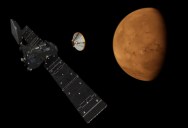The ESA Orbiter Has Sent Back Martian Images Dotted With Giant “Spiders”
by Trisha Leigh

I know it’s going to be awhile before astronauts head to Mars.
So it will be even longer before other people might need to settle here – if that ever become a possibility at all.
All I’m saying is, if it’s rife with spiders, I’m not going to be sorry to miss out on the trip.
The European Space Agency’s (ESA) ExoMars Trace Gas Orbiter sent back images from the southern polar region of Mars – images that appear to be giant spiders on the surface.
But fooled ya!

Because they’re just features in the ice as spring crawls across the planet.
“These small, dark features form when spring sunshine falls on layers of carbon dioxide deposited over the dark winter months. The sunlight causes carbon dioxide ice at the bottom of the layer to turn into gas, which subsequently builds up and breaks through slabs of overlying ice. The gas bursts free in Martian springtime, dragging dark material up to the surface as it goes and shattering layers of ice up to a metre thick.”
The emerging gas pushes up dust and sand, creating giant fountains that crash back to the surface. It creates the dark “spider-like” patches seen in the image.
And honestly, experts like Dr. Jess Taubert say they only look like spiders because of pareidolia – the tendency for human beings to see familiar patterns in objects.
Historically, it helped us identify danger, and people who used it to their advantage typically survived.
“Our brain is constantly trying to make sense of the outside world. One way the brain accomplishes this goal is by detecting and learning patterns, which are essentially statistical regularities in the environment, because these patterns help the brain decide how to react or behave in order to survive.”
That said, in the modern world, pareidolia can also lead to just seeing things where they don’t exist.
Sorry, to all of those spider lovers out there.
You’ll have to be content with the species here on Earth.
At least for now.
If you thought that was interesting, you might like to read about a quantum computer simulation that has “reversed time” and physics may never be the same.
Categories: STORIES
Tags: · esa, ice, mars, pareidolia, science, single topic, spiders, spring, top

Sign up to get our BEST stories of the week straight to your inbox.




